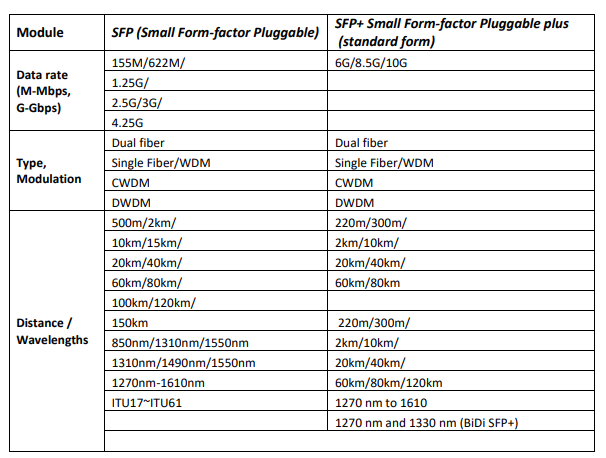

 Knowledge Base +
Knowledge Base +  2024.01.12
2024.01.12SFP vs. SFP+ SFP supports 10/1000Mbps Ethernet speed, SFP+ is an updated version that supports higher speeds up to 10Gbps and this is the primary difference between SFP and SFP+. Du to the differerent data rate, the applications and transmission distance is also different. SFP+ typically has a longer transmission distance. SFP+ specifications are based on SFF-8431. In terms of SFP vs. SFP+ compatibility, SFP+ ports often accept SFP optics but at a reduced speed of 1Gbps. However, be aware, you cannot plug an SFP+ transceiver into an SFP port because SFP+ does not support speeds less than 1Gbps. SFP+ module becomes the most popular 10 Gigabit Ethernet module in the market.
The following is a table of comparison between SFP and SFP+:

SFP and SFP+ have the same size and appearance. From the price, SFP+ is usually more expensive than SFP. The main difference between SFP and SFP+ is that the SFP+ is used in Gigabit Ethernet applications while SFP is for 100Bse or 1000Base applications. SFP doesn't support 10G transmission data rate, which means they can't be used in the same network. SFP+ transceivers use the same dimensions of pluggable transceivers in the 10Gbs Ethernet and 8.5Gbs fiber channel with SFP. SFP comply with standards of IEEE802.3 and SFF-8472 while SFP+ is based on SFF-8431.
How to Choose SFP Transceivers?
In addition to SFP vs SFP+ vs QSFP, you’ll also need to consider the application. SFP transceivers are available in different types depending on what they will be used for, for example, single-mode vs multimode SFP. Single-mode SFP transceivers work with single-mode fiber, whereas multimode SFPs are compatible with multimode fiber. Additionally, there are long-reach WDM SFP transceivers for multiplexing, simplex SFPs for single fiber applications, video SFP transceivers for transmission of high-definition video, and PON SFP transceivers for fiber-based access networks. SFPs are available in commercial and extended operating temperature ranges, with or without extended diagnostics capabilities.
Frequently Asked Question about Single Mode vs Multimode Fiber Optic Cable
Q: What is better single mode or multimode fiber type?
A: As has been mentioned above, single mode fiber and multimode fiber cable have their own advantages on cost and applications. There is no such thing that single mode optical fibers are better than multimode ones. Just choosing the best-fit one for your applications is ok.
Q: Can I mix single mode and multimode fiber type?
A: This answer for this question is “no”. Multimode fiber and single mode fiber have different core sizes, and the number of light modes that they transmit is also different. If you mix the two fibers, or connect them together directly, you’ll lose a large amount of optical loss, resulting in a link flapping or being down. Keep in mind that never mix different types of cabling randomly.
Q: Can I use a multimode transceiver on single mode fiber optic cable?
A: Generally speaking, the answer is "no". Large optical loss will occur if a multimode transceiver is connected with single mode fiber. However, the opposite will work. For example, 1000BASE-LX single mode SFP can work on multimode fiber cable by using mode conditioning fiber cable. Sometimes, fiber media converters also can be used to solve such problems between single mode transceivers and multimode transceivers.
Q: Single mode vs multimode fiber optic cable type: which should I choose?
A: When making a decision between single mode and multimode fiber cables, the first factor to consider is the fiber distance which you need actually. For example, in a data center, multimode fiber cables are enough for the distance of 300-400 meters. While in applications that require distance up to several thousands of meters, the single mode fiber is the best choice. And in applications that can use single mode and multimode fiber, other factors like cost and future upgrade requirements should be taken into consideration for your choice.
Subscribe to the newsletter
for all the latest updates.
2-5# Building, Tongfuyu Industrial Zone, Aiqun Road, Shiyan Street, Baoan District, Shenzhen. China
